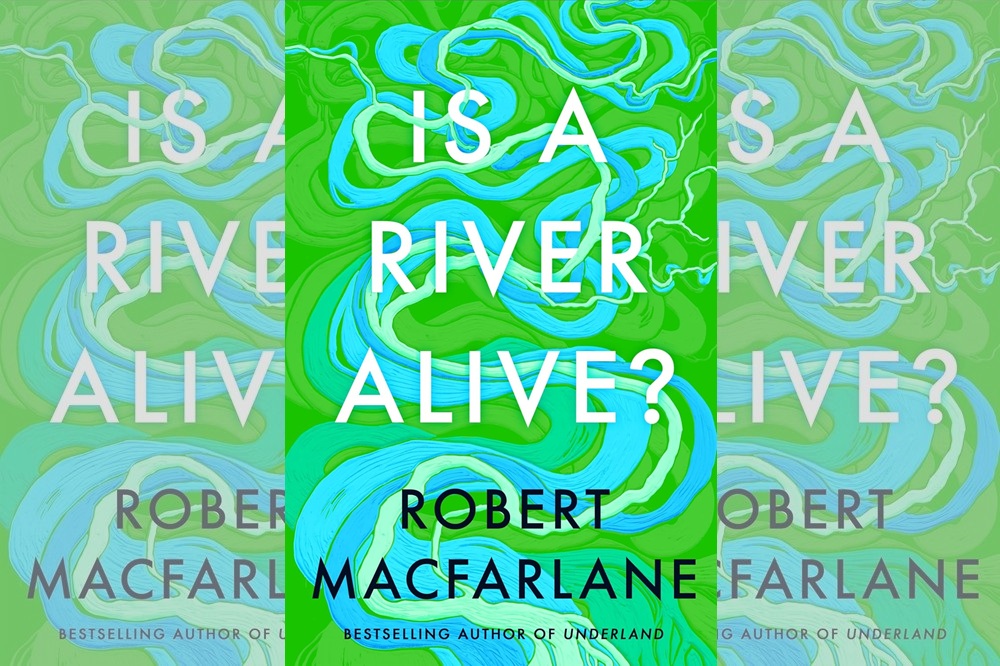Book review: Is a River Alive? by Robert Macfarlane

Jon Gower
In the poet Harri Webb’s poem ‘The Nightingales’ he sings of the myriad rivers of Wales, from those that run free, white and wild, such as the Rhiangoll, Tarrell and Crawnon that cut through Bannau Brycheiniog to those whose flow is stultified behind dams such as ‘Elan, Claerwen, Fyrnwy/Or Tryweryn of the Shame.’
He also tells of the polluted watercourses of ‘Black Rhymni, sullen Ogwr, dirty Ebbw/Dishonoured Tawe and all our sewered drabs’ – all rivers that had been variously poisoned and polluted by the outflows and effluent of south Wales’ industry.
Sadly, to that riverine roster can now be added the deoxygenated Wye where declining salmon numbers are just one indication of what writer Matthew G.Rees has dubbed “the gasping exhaustion of the river.”
So when Robert Macfarlane, in one of this summer’s non-fiction bestsellers, posits the question ‘Is a River Alive?’ he is challenging the idea that a river should be a receptacle, sewer and sump for human activity but, rather should be afforded rights and respect just as that given any other living thing.
Cloud forest
To find the answer he visits very different rivers. In northern Ecuador he enters the cloud forest of Los Cedros, alive with life, all sustained by the watery ecosystem of drifting mist. It is a ‘living Wunderkammer.
It is the home of fabulous beasts, birds, plants and fungi who could have flown, crawled and grown straight out of Hieronymus Bosch’s imagination: the spiny pocket mouse, the strangler fig, the white-headed capuchin, the devil’s fingers fungus, the spectacled bear, the dwarf squirrel, the river otter, the jaguarundi, the golden-headed quetzal, the black-and-chestnut eagle…’ not to mention at least a dozen species of hummingbird, ‘thimblefuls of molten metal who whir from flower to flower.’
Abundance
This fecund abundance of life was threatened by gold mining, with its attendant use of mercury but salvation came in the form of a progressive and original new Constitution drawn up by the Ecuadorean government.
This included articles which have become known as “The Rights of Nature,” including a ‘right to water’, since ‘its condition as an essential element for life makes it a necessary aspect for the existence of all living beings.’
Such protection by the state is totally absent in the case of the dead and dying rivers of Chennai in India.
In one such river, the Cooum, the number of fish species plummeted from forty nine species in 1949 to none in 2000. None. Zero.
Use of rivers as sewers by a city with some of the highest population densities in India has led to an estimated 55 million litres of effluents and sewage being discharged daily into its three principal waterways.
It’s little wonder that an official report in 2023 found that across a range of sample sites the water was ‘unfit for any kind of life form as there is no dissolved oxygen.’
Expert guides
In all of his various visits Macfarlane is blessed by the company of expert guides such as Guiliana who has a metaphysical ability to locate small fungi in the vast swathes of South American cloud-forest and Yuvan in Chennai who works to ‘reanimate new-old seeing and listening’ to rivers.’
When the undertakes the most physically arduous of his river journeys he does so in the company of an old friend, Wayne Chambliss. They are joined by expert kayakers to travel a hundred miles down the Mutehekau Shipu or Magpie River in north-eastern Quebec.
Their journey includes a meeting with an Innu poet and activist Rita Meshoko who helped ensure that this was the first Canadian river to be be recognised as a living, rights-bearing being.
She encourages the travellers to ask the river one question and not to waste the opportunity and asks them to gather some Lavender tea for her. The book is full of meetings with remarkable people.
Dam damage
The main threat to the rivers of Canada is hydroelectricity and the Mutehekau is no exception as plans have already been drawn up to create a dam along its course.
In following its course the Cambridge don sees the damage that could be wrought to the river should such engineering works ensue. He also has his own epiphany when the river speaks to him, no longer a voiceless flow of water but a living, breathing, vocal being.
There will be those readers, myself included, who had their doubts about whether Macfarlane could ever improve upon the magisterial underground adventures and meditations of ‘Underland.’
But ‘Is a River Alive?’ does that and then some and the final chapter of this exquisitely written and urgently timely book is well-nigh emotionally incapacitating.
It’s life enhancing even as it considers human profligacy; uplifting even as it visits those dead rivers of eastern India. Here, where the river meets the sea a volunteer spends nights on end on Turtle Patrol, rescuing their eggs from predators including dogs.
When Macfarlane asks him why he does this, the man looks somewhat puzzled. “For life,’ he replies simply. Which might well explain the ultimate raison d’être of this vital, vibrant and profoundly necessary book. It is nothing less than a magnificent achievement.
Support our Nation today
For the price of a cup of coffee a month you can help us create an independent, not-for-profit, national news service for the people of Wales, by the people of Wales.







